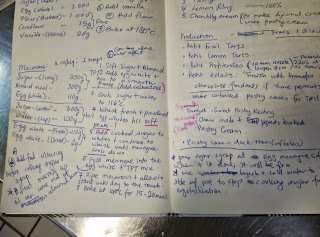Tafe Ryde: Fourth attempt at baking macarons
Macarons must be one of the hardest cookies ever to make. As a classmate said, it's not a straight cookie, which makes it a lot more intriguing than your average cookie. :-)
For class last week, I was assigned by Chef Deborah to make petit fours.... haha...
Lots and lots of notes that I added to the recipe from last year... LOL.
Sifting the icing sugar, ground almond, and equal amounts of egg white
Egg white powder, in other words.
Preparing the sugar syrup for the Italian meringue. Chef Deborah used the traditional way of testing the readiness of the syrup by placing her fingers in cold water and dipping it into the syrup.
Prepare a brush and cold water in a gastronome to prevent sugar from caramelizing on the sides of the pot.
Food colouring. Chef chose the yellow colour.
Folding the italian meringue into the TPT mixture.
As you can see, the colour wasnt strong enough and needs to be more garish.
Fold the meringue into the TPT mixture twice. First roughly, but in the second fold, to keep as much aeration within the egg meringue.
Perfectly piped round shapes? Let it form a crust for about 15 minutes.
Bake for about 20 mins. Remove damper and let it dry for about 15mins-ish.
Reheating left over choc ganache from the previous classes on a bain marie.
Piped and ready to be served.
Key points to remember when making macarons:
1) Take care when sifting the ground almond as not to bring the oil out.
2) Dried egg white helps...
3) According to Chef Deborah, the sugar syrup can go up to a maximum of 118 degrees celcius.
Whilst waiting for the sugar syrup to heat up, the egg white can be slowly beaten with the dried egg powder. Take the sugar syrup off the heat and then start beating the meringue furiously.











Comments